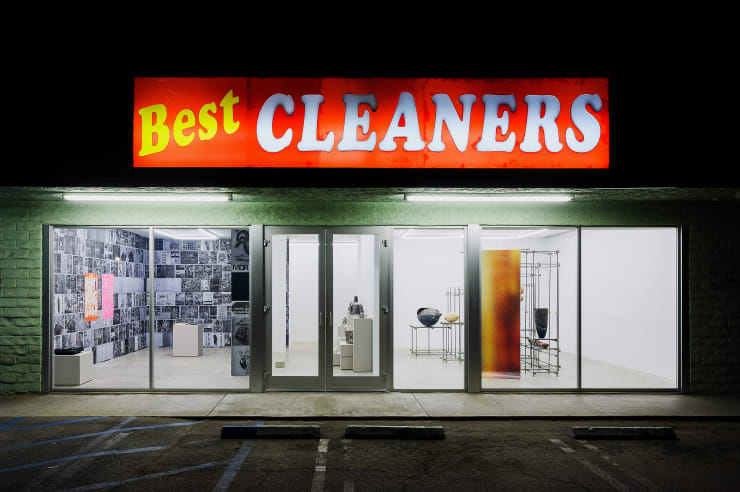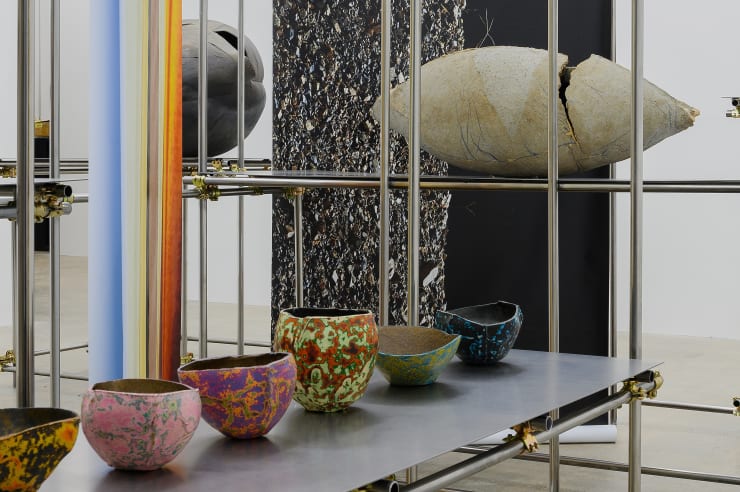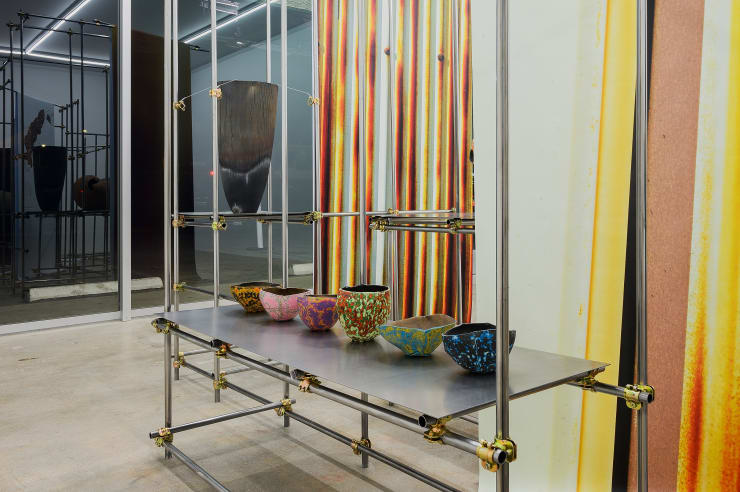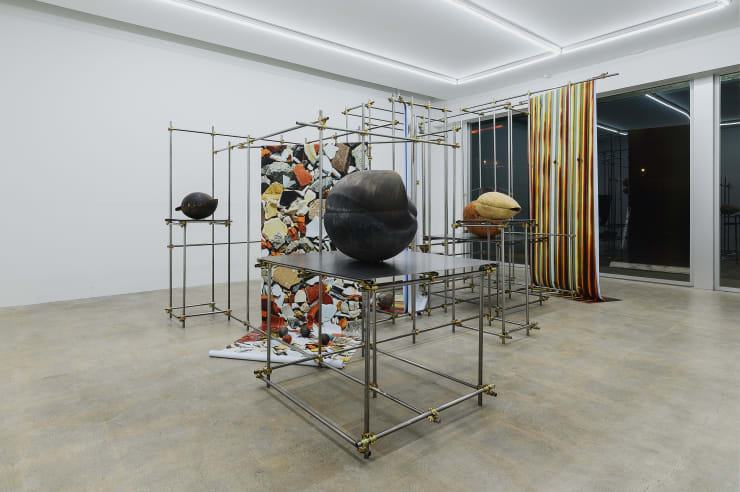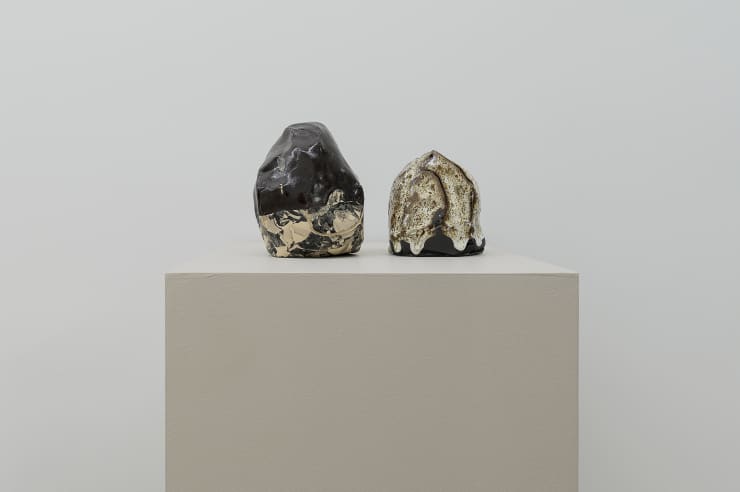Keita Matsunaga
Press:
Los Angeles Times, January 15, 2020
Art Viewer, January 14, 2020
Nonaka-Hill is pleased to present new ceramic works by Japanese artist Keita Matsunaga in his first solo exhibition in the United States. The exhibition is on view through January 25th, 2020.
Born in 1986, Keita Matsunaga describes his generation as one which is concerned with all kinds of ideas of repair, renewal, remix and reuse. Citing major earthquakes and complex global concerns, the artist has incorporated this contemplation into the materials, processes and surface techniques of his sculptural ceramic practice. Another influence is architecture.
Matsunaga was raised by ceramic artist parents in Ichinokura, a town known for sake cup production in the ceramic industry region of Tajimi, Gifu. Ichinokura’s makers have long faces significant production and distribution obstacles; a limited supply of local clay forces reliance on clays brought in from elsewhere, and the town’s narrow streets prohibit passage of large trucks. The town’s production of sake cups and small ceramic wares can be understood as an adaption to these conditions.
Matsunaga left Ichinokura to study architecture, eventually finding work in the studio of the prominent architect, Sou Fujimoto, whom the artist cites as a major influence. According to Matsunaga, Fujimoto “asks the big questions” of the fundamental concepts of architecture. So, when Matsunaga realized that he was better suited for a life working in ceramics, he returned to Tajimi with an architect’s tendency to scrutinize the site conditions as a means to find inspiration for the project at hand. Of course, history informs architectural and ceramic decisions, as well.
The artist explains that the shape of a bowl evolves from the primal human action of scooping water with two hands to nourish oneself. The invention of the bowl allowed humans to share nourishment between people and must have had an immeasurable effect on the development of human communication. In Japan, the role of the tea-bowl in the high-art of tea-ceremony illustrates this point to an extreme. Matsunaga’s tea-bowls are covered with urushi (lacquer), which hasn’t been seen on ceramic bowls since the Jomon Era, from 9,000 to 3,000 years ago. Urushi was replaced by glaze, which is more efficient to produce, and urushi was relegated to a repair material for ceramics, used only as the crack-filler for kintsugi (gold leaf) repairs. Matsunaga finds significance in the use of a repair material as full surface coverage for his teabowls, while at the same time renewing a Jomon practice. Matsunaga has remarked that his urushi color choices recall the ornate and colorful Kunitani-ware (aesthetically opposite of Jomon) of Kanazawa area where he studied ceramics. Another personal association for Matsunaga’s bright colors may be a childhood-memories of swimming in rivers polluted by glazes dumped from ceramic factories, changing the river’s color day-by-day with unusual color combinations. The show’s largest work, from his “Void - surfaced with caution orange urushi that’s been muted black.
Matsunaga finds equivalence between the physical act of making architectural models and of making ceramic sculpture; the object can be imagined in scales beyond itself. Similarly, Matsunaga’s shell-like “Void” works possess an undeniable exterior object-hood, so their title “Void” can only provoke contemplation of the object’s mysterious, perhaps infinite, inner-space. Some of these “Void” works utilize “ordered-in” clays from various sources, rolled into thin sheets and loosely layered. When fired, these different types of clay react in opposition to each other, creating fissures. Some of these works are fired in barley husks which To display works which were made in Japan, the artist designed a multi-tiered metal scaffold, draped with digital photographs printed with intense color saturation onto vinyl rolls. The images bring the artist’s Japanese studio environment into the Los Angeles gallery; dappled light through a window, stains on a kiln plank, a rusted corrugated metal studio wall, and views of broken glazed ceramics by many contemporary makers accumulated into a landfill. The works on view in the gallery’s central space were created during Matsunaga’s recent residency at Cal State University Long Beach’s Center for Contemporary Ceramics, invited by the program founder, artist Tony Marsh. To begin these works, Matsunaga mixed bits of broken, glazed ceramics from the CSULB studios’ waste-bins, studding the new, moist clay and formed sculptures. He applied photographic glaze decals with images from his Tajimi environs; his rusted metal studio wall and images of the Tajimi ceramicists’ community landfill of broken glazed ceramics. Upon firing, the B&W photographic images adhered to the forms’ surfaces and the chips’ glazes reactivated, bubbling up from within to appear like splatters on the surface. Photographic images of broken clay enveloping a form of unbroken clay invokes the reflexive surrealism of Rene Magritte, while another comparison can be made to the Japanese Mono-ha artist, Koji Enokura, whose painting objects picture repeated stains, transported via silkscreen process, conflating object and image to uncanny effect. At the same time, the artist has drawn two ceramics communities together on one object – thoughtfully combining the material of the form with the treatment of the surface.
Keita Matsunaga (b. 1986, Japan) works in Tajimi and Kani in Gifu Prefecture, Japan. He studied architecture at Meijo University, Nagoya, Aichi Prefecture and subsequently studied ceramics at Tajimi City Pottery Design, Tajimi and Technical Center and Kanazawa Utatsuyama Kogei Kobo, Kanazawa, Ishikawa Prefecture. He has had numerous exhibitions in Japan including solo exhibitions at Tondo, Kyoto (2019); Pragmata, Tokyo (2016, 2019); Nihonbashi Mitsukoshi Main Store, Tokyo (2018); Utsuwa Note, Saitama (2016, 2018); Meguro Togeikan, Mie (2017); and group exhibitions at Paramita Museum, Mie (2019); SHOP Taka Ishii Gallery, Hong Kong (2019); Gallery Voice, Gifu (2016, 2018); Ichinokura Sakasuki Art Museum (2017); Nihonbashi Mitsukoshi Main Store, Tokyo (2016, 2017, 2018); Ginza Mitsukoshi, Tokyo (2015, 2016, 2017), Sokyo, Kyoto (2017); 21st Century Museum of Art, Kanazawa (2015); and Espace L’Une, Paris (2015). Matsunaga also has been selected for the 11th International Ceramic Exhibition, Mino, Gifu (2017); and he won the Encouragement Award at the 72nd Kanazawa Kogei Exhibition, Kanazawa (2016); selected for the 23rd Japan Ceramic Exhibition (2015), won the Encouragement Award at the International Itami Craft Exhibition, Hyogo (2014), and won Grand Prize at the Takaoka Contemporary Craft Competition, Toyama (2013). His work is in the permanent collection of The Museum of Ceramic Art, Hyogo.
 Keita Matsunaga蛻-Void-monuke, 2019Ceramic, urushi, glaze.17-3/16 x 28-3/8 x 15-3/16 in
Keita Matsunaga蛻-Void-monuke, 2019Ceramic, urushi, glaze.17-3/16 x 28-3/8 x 15-3/16 in
43.5 x 72 x 38.5 cm Keita Matsunaga蛻-Void-monuke, 2019Ceramic, minerals.18-3/4 x 24-1/4 x 18-1/8 in
Keita Matsunaga蛻-Void-monuke, 2019Ceramic, minerals.18-3/4 x 24-1/4 x 18-1/8 in
47.5 x 61.5 x 46 cm 蛻-Void-monuke, 2017
蛻-Void-monuke, 2017 Keita MatsunagaOrganism, 2019Ceramic, glaze, decal.4-1/2 x 4-1/2 x 3-3/4 inches
Keita MatsunagaOrganism, 2019Ceramic, glaze, decal.4-1/2 x 4-1/2 x 3-3/4 inches
11.4 x 11.4 x 9.5 cm Keita MatsunagaOrganism, 2019Ceramic, glaze, decal.4-1/2 x 4-1/2 x 4-1/4 inches
Keita MatsunagaOrganism, 2019Ceramic, glaze, decal.4-1/2 x 4-1/2 x 4-1/4 inches
11.4 x 11.4 x 10.8 cm Keita MatsunagaOrganism, 2019Ceramic, glaze, decal.4-3/4 x 4-1/2 x 4-3/8 in
Keita MatsunagaOrganism, 2019Ceramic, glaze, decal.4-3/4 x 4-1/2 x 4-3/8 in
12.1 x 11.4 x 11.1 cm Keita MatsunagaOrganism, 2019Ceramic, decal.5-1/8 x 5-5/8 x 5-1/4 inches
Keita MatsunagaOrganism, 2019Ceramic, decal.5-1/8 x 5-5/8 x 5-1/4 inches
13 x 14.3 x 13.3 cm Keita MatsunagaOrganism, 2019Ceramic, glaze, decal.5-3/4 x 5-1/4 x 4-7/8 inches
Keita MatsunagaOrganism, 2019Ceramic, glaze, decal.5-3/4 x 5-1/4 x 4-7/8 inches
14.6 x 13.3 x 12.4 cm Keita MatsunagaOrganism, 2019Ceramic, glaze, decal.2 x 4-1/4 x 10-1/8 inches
Keita MatsunagaOrganism, 2019Ceramic, glaze, decal.2 x 4-1/4 x 10-1/8 inches
5.1 x 10.8 x 25.7 cm Keita MatsunagaOrganism, 2019Ceramic, glaze, decal.5 x 4 3/4 x 8 7/8 in
Keita MatsunagaOrganism, 2019Ceramic, glaze, decal.5 x 4 3/4 x 8 7/8 in
12.7 x 12.1 x 22.5 cm Keita MatsunagaOrganism, 2019Ceramic, glaze, decal.11 3/4 x 13 3/8 x 13 in
Keita MatsunagaOrganism, 2019Ceramic, glaze, decal.11 3/4 x 13 3/8 x 13 in
29.8 x 34 x 33 cm Keita MatsunagaOrganism, 2019Ceramic, glaze, decal.23 x 10 x 10 in
Keita MatsunagaOrganism, 2019Ceramic, glaze, decal.23 x 10 x 10 in
58.4 x 25.4 x 25.4 cm Keita MatsunagaOrganism, 2019Ceramic, glaze, decal.15 1/4 x 14 x 14 1/2 in
Keita MatsunagaOrganism, 2019Ceramic, glaze, decal.15 1/4 x 14 x 14 1/2 in
38.7 x 35.6 x 36.8 cm Keita MatsunagaOrganism, 2019Ceramic, glaze, decal. Plexi "tomobako" box.1) 4-1/8 x 10-5/8 x 7-5/8 inches
Keita MatsunagaOrganism, 2019Ceramic, glaze, decal. Plexi "tomobako" box.1) 4-1/8 x 10-5/8 x 7-5/8 inches
1) 10.5 x 27 x 19.4 cm
2) 4-1/4 x 11-1/8 x 5 inches
2) 10.8 x 28.3 x 12.7 cm
case) 21 x 13-1/8 x 7-1/2 inches
case) 53.3 x 33.3 x 19.1 cm Keita MatsunagaOrganism, 2019Ceramic, glaze, decal.3-1/2 x 5-3/4 x 5-1/4 in
Keita MatsunagaOrganism, 2019Ceramic, glaze, decal.3-1/2 x 5-3/4 x 5-1/4 in
8.9 x 14.6 x 13.3 cm Keita MatsunagaSpirit of the Ima Bean, 2019Ceramic, glaze, decal.9-7/8 x 7-5/8 x 8-3/4 in
Keita MatsunagaSpirit of the Ima Bean, 2019Ceramic, glaze, decal.9-7/8 x 7-5/8 x 8-3/4 in
25.1 x 19.4 x 22.2 cm Keita Matsunagaまばたき - Void - Mabataki, 2017Ceramic, Urushi.6 x 11 x 13-3/4 in
Keita Matsunagaまばたき - Void - Mabataki, 2017Ceramic, Urushi.6 x 11 x 13-3/4 in
15 x 28 x 35 cm Keita Matsunaga層象-Improvised stratum, 2019Ceramic, minerals.22-1/16 x 10-11/16 x 10-1/4 in
Keita Matsunaga層象-Improvised stratum, 2019Ceramic, minerals.22-1/16 x 10-11/16 x 10-1/4 in
56 x 27 x 26 cm Keita Matsunaga手話 (A) - Shuwa (A), 2019Ceramic, urushi5-15/16 x 7-7/8 x 6-15/16 inches
Keita Matsunaga手話 (A) - Shuwa (A), 2019Ceramic, urushi5-15/16 x 7-7/8 x 6-15/16 inches
15 x 20 x 17.5 cm Keita Matsunaga手話 (B) - Shuwa (B), 2019Ceramic, urushi5-15/16 x 7-9/16 x 6-5/16 in
Keita Matsunaga手話 (B) - Shuwa (B), 2019Ceramic, urushi5-15/16 x 7-9/16 x 6-5/16 in
15 x 19.2 x 16 cm Keita Matsunaga手話 (C) - Shuwa (C), 2019Ceramic, urushi6-5/16 x 7-1/2 x 6-1/2 in
Keita Matsunaga手話 (C) - Shuwa (C), 2019Ceramic, urushi6-5/16 x 7-1/2 x 6-1/2 in
16 x 19 x 16.5 cm Keita Matsunaga脈脈 - Myaku myaku, 2017Ceramic6-3/8 x 9-1/2 x 6-3/8 inches
Keita Matsunaga脈脈 - Myaku myaku, 2017Ceramic6-3/8 x 9-1/2 x 6-3/8 inches
16 x 24 x 16 cm Keita Matsunaga脈脈 - Myaku myaku - シャボン玉・石鹸玉 Bubble, 2019Ceramic, urushi lacquer, glaze.
Keita Matsunaga脈脈 - Myaku myaku - シャボン玉・石鹸玉 Bubble, 2019Ceramic, urushi lacquer, glaze.
Paulownia wood "tomobako" box, signed in ink, cotton, paper.2-7/8 x 7 x 6 in
7.3 x 17.8 x 15.2 cm Keita Matsunaga脈脈 - Myaku myaku - 春愁 Spring Shade, 2019Ceramic, urushi lacquer, glaze.
Keita Matsunaga脈脈 - Myaku myaku - 春愁 Spring Shade, 2019Ceramic, urushi lacquer, glaze.
Paulownia wood "tomobako" box, signed in ink, cotton, paper.3-1/4 x 5-3/4 x 5 in
8.3 x 14.6 x 12.7 cm Keita Matsunaga脈脈- Myaku myaku - すみれ Violet, 2020Ceramic, urushi lacquer, glaze.
Keita Matsunaga脈脈- Myaku myaku - すみれ Violet, 2020Ceramic, urushi lacquer, glaze.
Paulownia wood "tomobako" box, signed in ink, cotton, paper.3-3/8 x 4-7/8 x 4-3/4 in
8.6 x 12.4 x 12 cm Keita Matsunaga脈脈- Myaku myaku - シャボン玉 Bubble , 2020Ceramic, urushi lacquer, glaze.
Keita Matsunaga脈脈- Myaku myaku - シャボン玉 Bubble , 2020Ceramic, urushi lacquer, glaze.
Paulownia wood "tomobako" box, signed in ink, cotton, paper.3-1/8 x 5-1/8 x 4-1/2 in
8 x 13 x 11.5 cm Keita Matsunaga脈脈 -Myaku myaku -荒野 Wilderness, 2019Ceramic, urushi lacquer, glaze.
Keita Matsunaga脈脈 -Myaku myaku -荒野 Wilderness, 2019Ceramic, urushi lacquer, glaze.
Paulownia wood "tomobako" box, signed in ink, cotton, paper.3-1/8 x 6 x 5-1/4 in.
7.9 x 15.2 x 13.3 cm Keita Matsunaga脈脈 - Myaku myaku - 柘榴 Pomegranate, 2019Ceramic, urushi lacquer, glaze,
Keita Matsunaga脈脈 - Myaku myaku - 柘榴 Pomegranate, 2019Ceramic, urushi lacquer, glaze,
Paulownia wood "tomobako" box, signed in ink, cotton, paper.3-1/8 x 5-1/2 x 5-1/4 in
7.9 x 14 x 13.3 cm Keita Matsunaga脈脈- Myaku myaku - 星朧 Stardust, 2019Ceramic, urushi lacquer, glaze.3-3/8 x 5-3/4 x 5-1/4 in
Keita Matsunaga脈脈- Myaku myaku - 星朧 Stardust, 2019Ceramic, urushi lacquer, glaze.3-3/8 x 5-3/4 x 5-1/4 in
8.6 x 14.6 x 13.3 cm Keita Matsunaga蛻-Void-monuke, 2018Ceramic, minerals8-7/8 x 8-11/16 x 17-3/8 in
Keita Matsunaga蛻-Void-monuke, 2018Ceramic, minerals8-7/8 x 8-11/16 x 17-3/8 in
22.5 x 22 x 44 cm Keita Matsunaga蛻-Void-Monuke, 2018Ceramic, minerals3-1/4 x 3-1/4 x 4-3/8 inches
Keita Matsunaga蛻-Void-Monuke, 2018Ceramic, minerals3-1/4 x 3-1/4 x 4-3/8 inches
8.1 x 8.1 x 11 cm Keita Matsunaga蛻-Void-monuke, 2018Ceramic, glaze3-3/16 x 3-3/16 x 4-3/8 inches
Keita Matsunaga蛻-Void-monuke, 2018Ceramic, glaze3-3/16 x 3-3/16 x 4-3/8 inches
8 x 8 x 11 cm Keita Matsunaga蛻-Void-monuke, 2018Ceramic, glaze6-1/2 x 10-3/16 x 7-5/8 inches
Keita Matsunaga蛻-Void-monuke, 2018Ceramic, glaze6-1/2 x 10-3/16 x 7-5/8 inches
16.5 x 25.8 x 19.3 cm Keita Matsunaga蛻-Void-monuke, 2018Ceramic, urushi8-11/16 x 10-7/16 x 13-15/16 inches
Keita Matsunaga蛻-Void-monuke, 2018Ceramic, urushi8-11/16 x 10-7/16 x 13-15/16 inches
22 x 26.5 x 35.3 cm Keita Matsunaga蛻-Void-monuke, 2019Ceramic, urushi, glaze.
Keita Matsunaga蛻-Void-monuke, 2019Ceramic, urushi, glaze.
Paulownia wood "tomobako" box, signed in ink, cotton, paper.3-3/16 x 3-3/16 x 3-15/16 in
8 x 8 x 10 cm Keita Matsunaga蛻-Void-monuke, 2019Ceramic, glaze, minerals.
Keita Matsunaga蛻-Void-monuke, 2019Ceramic, glaze, minerals.
Paulownia wood "tomobako" box, signed in ink, cotton, paper.3-1/16 x 3-1/16 x 4-3/16 in
7.8 x 7.8 x 10.5 cm
Related artist
Artist Exhibited:
Ulala Imai
Kazuo Kadonaga
Kentaro Kawabata
Zenzaburo Kojima
Kisho Kurokawa
Tadaaki Kuwayama
Toshio Matsumoto
Keita Matsunaga
Yutaka Matsuzawa
Kimiyo Mishima
Kunié Sugiura
Takuro Tamayama
Tiger Tateishi
Sofu Teshigahara
Shomei Tomatsu
Wataru Tominaga
Hosai Matsubayashi XVI
Kansuke Yamamoto
Masaomi Yasunaga
Exhibitions:
-2025-
KEY HIRAGA: The Elegant Life of Mr. H
-2024-
KYOKO IDETSU: What can an ideology do for me?
KENTARO KAWABATA / BRUCE NAUMAN
SAORI (MADOKORO) AKUTAGAWA: CENTENARIA
Keita Matsunaga : Accumulation Flow
-2023-
NONAKA-HILL ♥ TATAMI ANTIQUES: A holiday sale of unique objects from Japan
TAKASHI HOMMA : REVOLUTION No.9 / Camera Obscura Studies
TATSUMI HIJIKATA THE LAST BUTOH: Photographs by Yasuo Kuroda
Kiyomizu Rokubey VIII: CERAMIC SIGHT
Masaomi Yasunaga: 石拾いからの発見 / discoveries from picking up stones
SHUZO AZUCHI GULLIVER ‘Synogenesis’
Koichi Enomoto: Against the day
Tatsuo Ikeda / Michael E. Smith
Hiroshi Sugito: the garden with Zenzaburo Kojima
Zenzaburo Kojima: This very green
Tomohisa Obana: To see the rainbow at night, I must make it myself
Daisuke Fukunaga: Beautiful Work
- 2021 -
Natsuyasumi: In the Beginning Was Love
Takashi Homma: mushrooms from the forest
– 2020 –
Hosai Matsubayashi XVI & Trevor Shimizu
Sterling Ruby and Masaomi Yasunaga
– 2019 –
A show about an architectural monograph
Yutaka Matsuzawa
Yutaka Matsuzawa through the lens of Mitsutoshi Hanaga
Takuro Tamayama & Tiger Tateishi
Kunié Sugiura
Masaomi Yasunaga
Miho Dohi
Wataru Tominaga
Naotaka Hiro
Parergon: Japanese Art of the 1980s and 1990s
Tadaaki Kuwayama
– 2018 –
Toshio Matsumoto
Kentaro Kawabata
Kansuke Yamamoto
Kazuo Kadonaga: Wood / Paper / Bamboo / Glass
Press:
-2025-
Artillery Magazine, Sawako Goda
-2024-
Artsy, Nonaka-Hill
Richesse, Nonaka-Hill Kyoto
Bijutsutecho, Nonaka-Hill Kyoto
The Art Newspaper, Nonaka-Hill Kyoto
Meer, Kyoko Idetsu
Bijyutsutecho, Masaomi Yasunaga
Switch, Masaomi Yasunaga
ARTnews JAPAN, Masaomi Yasunaga
Richesse, Masaomi Yasunaga
Art Basel, Daisuke Fukunaga, Imai Ulala
Art Basel, Kazuo Kadonaga, Sofu Teshigahara
-2023-
ADF webmagazine, Yasuo Kuroda, Tatsumi Hijikata
e-flux, Sanya Kantarofsky, Yasuo Kuroda
Los Angeles Times, Kenzi Shiokava
Artillery, Masaomi Yasunaga
Contemporary Art Daily Shuzo Azuchi Gulliver
- 2022 -
Contemporary Art Daily, Tomohisa Obana
ARTE FUSE, Daisuke Fukunaga
Contemporary Art Daily, Daisuke Fukunaga
Contemporary Art Review Los Angeles (Carla), Daisuke Fukunaga
What's on Los Angeles, Daisuke Fukunaga
Hyperallergic, Daisuke Fukunaga
Artillery, Kentaro Kawabata
Larchmont Buzz, entaro Kawabata
- 2021 -
Art Viewer, Natsuyasumi: In the Beginning Was Love
Hyperallergic, Natsuyasumi: In the Beginning Was Love
Art Viewer, Takashi Homma
Hyperallergic, Busy Work at Home
Art Viewer, Busy Work at Home
Hyperallergic, Ulala Imai
Contemporary Art Review Los Angeles (Carla), Ulala Imai
Contemporary Art Daily, Ulala Imai
artillery, Ulala Imai
Special Ops, Ulala Imai
Art Viewer, Ulala Imai
artillery, Matsubayashi & Trevor Shimizu
– 2020 –
Ceramic Now, Sterling Ryby and Masaomi Yasunaga
Hypebeast, Sterling Ryby and Masaomi Yasunaga
Art Viewer, Sterling Ruby and Masaomi Yasunaga
Air Mail, Sterling Ruby and Masaomi Yasunaga
Los Angeles Times, Kaz Oshiro
ArtnowLA, Kaz Oshiro
What's on Los Angeles, Kaz Oshiro
KCRW, Kaz Oshiro
Tique, Kaz Oshiro
Contemporary Art Daily, Kaz Oshiro
Art Viewer, Kaz Oshiro
Contemporary Art Daily, Sofu Teshigahara
Art Viewer, Sofu Teshigahara
KCRW, Sofu Tsshigahara
Hyperallergic, Nonaka-Hill
Los Angeles Times, Keita Matsunaga
– 2019 –
Los Angeles Times, Tatsumi Hijikata
Art Viewer, Tatsumi Hijikata, Eikoh Hosoe
Contemporary Art Review Los Angeles, Tatsumi Hijikata, Eikoh Hosoe
ArtAsiaPacific, Yutaka Matsuzawa
Los Angeles Times, Tatsumi Hijikata
AUTRE, Tatsumi Hijikata, Eikoh Hosoe
Los Angeles Times, Nonaka-Hill
ARTFORUM, Takuro Tamayama, Tiger Tateishi
Art Viewer, Takuro Tamayama, Tiger Tateishi
KCRW, Nonaka-Hill
LA WEEKLY, Nonaka-Hill
AUTRE, Takuro Tamayama, Tiger Tateishi
ArtsuZe, Takuro Tamayama, Tiger Tateishi
ARTFORUM, Review: Tadaaki Kuwayama, Rakuko Naito
Art Viewer, Masaomi Yasunaga, Kunié Sugiura
Los Angeles Times, Masaomi Yasunaga
KQED, Tadaaki Kuwayama, Rakuko Naito
Contemporary Art Daily, Naotaka Hiro, Wataru Tominaga, Miho Dohi
Los Angeles Times, Miho Dohi
Los Angeles Review of Books, Miho Dohi
Bijutsu Techo, Naotaka Hiro, Wataru Tominaga, Miho Dohi
Art Viewer, Miho Dohi
Art & Object, Parergon
COOL HUNTING, Felix Art Fair
Art Viewer, Tadaaki Kuwayama
artnet news, Nonaka-Hill
Contemporary Art Review Los Angeles (Carla), Tadaaki Kuwayama
– 2018 –
Art Viewer, Kentaro Kawabata
Contemporary Art Daily, Kazuo kadonaga
Los Angeles Times, Kazuo Kadonaga
ARTFORUM, Kazuo Kadonaga
Contemporary Art Daily, Shomei Tomatsu
KCRW, Kimiyo Mishima, Shomei Tomatsu
This website uses cookies
This site uses cookies to help make it more useful to you. Find out more about cookies.





































